North American F-82F/G
Twin Mustang
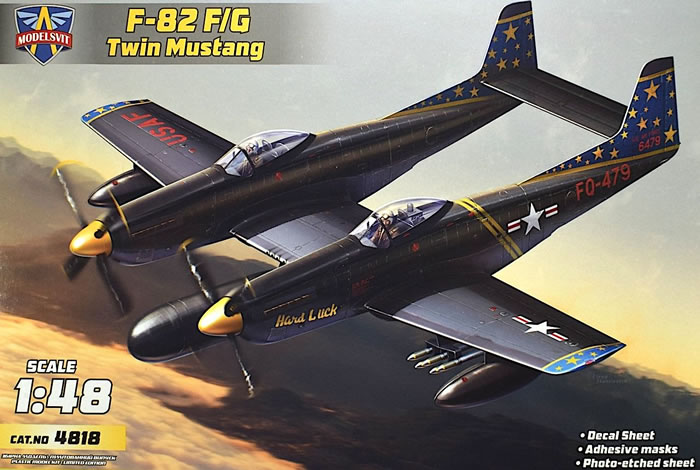
Modelsvit, 1/48 scale
S
u m m a r y |
| Catalogue Number: |
Modelsvit Kit No. 4818 - North American F-82F/G Twin Mustang |
| Scale: |
1/48 |
| Contents and Media: |
222 grey plastic parts; 14 parts in clear plastic; 25 photo-etched parts on one fret; die-cut masks; two decal sheets with markings and airframe stencils for for four options. |
| Price: |
€28.10 plus shipping available online from Modelsvit
£59.99 UK Price (£49.99 Export Price) Plus Shipping from Hannants
and retailers wordwide. |
| Review Type: |
FirstLook |
| Advantages: |
Surface details (recessed and in relief) are crispy executed and scale appropriate. There is a high level of detail throughout the model starting with pilot’s office and ending with the amazing wheel wells. A large PE fret (with seat harnesses), die-cut masks, and a colorful decal sheet with markings for 4 airframes rounds out a very nice model, indeed. |
| Disadvantages: |
There’s a bit of flash on some of the smaller parts and on the edges of a few of the larger parts as well. Some assembly steps appear to be quite fiddly so this is a kit best enjoyed by someone with previous experience with multi-media kits. |
| Recommendation: |
The surface textures are sublime, details abound, and the parts layout and assembly sequence are quite conventional. For those that like super-detailing, both of the cockpits and the radar nose cone can be displayed open. The beautifully printed decals provide markings for 4 colorful airframes and whichever scheme is applied, the result will be a head-turner for sure.
Highly Recommended! |
Reviewed by John Miller

The North American F-82 Twin Mustang was the last American piston-engined fighter ordered into production by the U.S. Air Force.
Based on the North American P-51 Mustang, the F-82 was originally designed as a long-range escort fighter for the Boeing B-29 Superfortress in World War II but the war ended well before the first production units were operational.
In the postwar era, the Strategic Air Command used the plane as a long-range escort fighter. Radar-equipped F-82s were used extensively by the Air Defense Command as replacements for the Northrop P-61 Black Widow as all-weather day/night interceptors.
During the Korean War, Japan-based F-82s were among the first USAF aircraft to operate over Korea.
The first three North Korean aircraft destroyed by U.S. forces were shot down by F-82s, the first being a North-Korean Yak-11 downed over Gimpo Airfield by the USAF 68th Fighter Squadron.
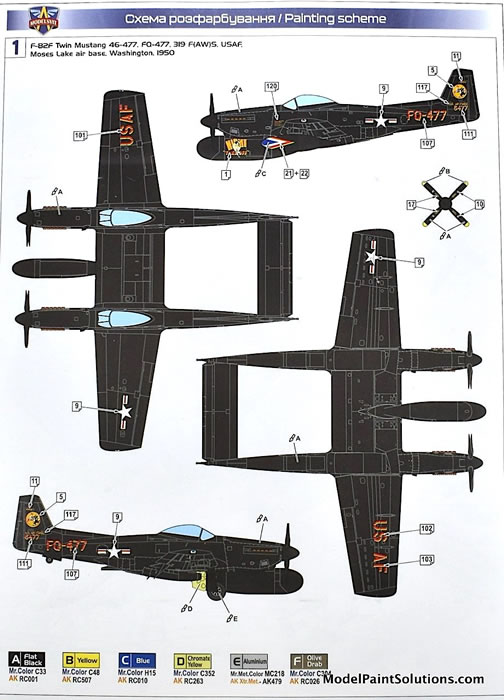
The Twin Mustang had a very short operational life. Approximately two years after its introduction to SAC, the F-82E was phased out of service in favor of the jet-powered Republic F-84E Thunderjet for bomber escort duties beginning in February 1950; the F-82Es were declared surplus by the end of the summer.
Some were modified into F-82Gs and sent to Korea for combat as replacement aircraft, others were converted to F-82Hs and sent to Alaska, but most were sent to storage at Robins AFB, Georgia and ultimately reclamation. The last remaining F-82Hs were sent to Elmendorf AFB, Alaska, for disposal in June 1953.
The last Twin Mustang that remained in the operational inventory was originally configured as an F-82G model that had served with two different squadrons in Okinawa and Japan. It was flown to Ladd AFB in 1952 and modified as a winterized F-82H. It was then sent to Elmendorf AFB and officially retired on 12 November 1953.
Text Edited from Wikipedia
The first thing that strikes you upon opening the rather large box is the high number of parts. Second to that is the abundance of very small parts. A weekend build this is not. The injected parts have a high level of detail but there’s a bit of flash to be dealt with so refreshing with sanding sticks and files will be required.
Surface textures (recessed and in relief) are crisply executed and scale appropriate. In short; the surface details are gorgeous. In particular, the recessed rivet lines and airframe fasteners are very well done rivaling anything I’ve seen on a Tamigawa or even Eduard.
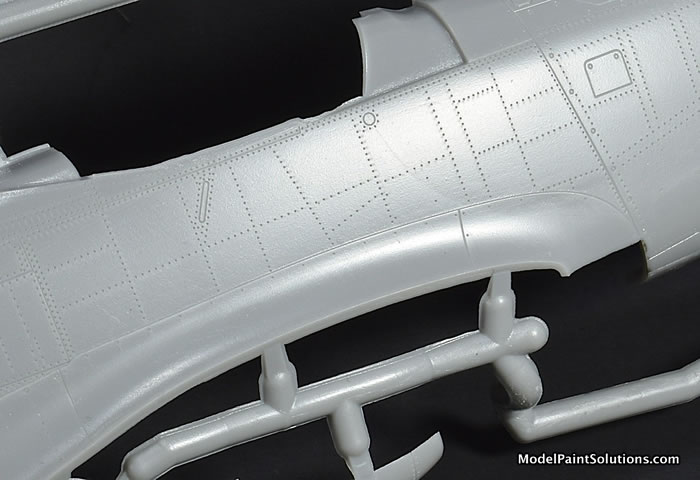
As with most aircraft kits this build entails many sub-assemblies; each comprised of multiple parts as well as a fair amount of photo-etch. As with their P-51H and XP-55 kits, the cockpits are a work of art in themselves. The detail here is about as good as one can reasonably expect from a current state-of-the-art kit and the results will be amazing. Each seat is comprised of 4 crisply molded parts plus a 5-piece PE harness. Next, the very detailed side panels, augmented with additional styrene and PE parts are added to the floorboards. Be mindful as some of the side panel details are specific for either the F or G variant. The addition of a firewall and a rear bulkhead to each assembly results in very detailed left and right cockpit tubs.

Next up are the left and right main instrument panels that are different both between themselves and between F and G models so study the instructions carefully here. The panel instrument faces are provided on a decal that is sandwiched between a styrene base and a PE part with the corresponding instrument bezels. Once assembled, the main panels, seats, and sticks are added to the left and right cockpit tubs completing the assemblies. Of note; although there were control sticks in both cockpits, the port cockpit was dedicated to the pilot while the starboard held the radar operator. The assembled cockpit tubs as well as ducting for the belly coolers and bulkheads for the tail wheel wells are trapped between the fuselage halves for both the left and right sides.

Next in sequence is the wing, which is comprised of a full-span lower piece with left and right upper halves. Each main wheel well is composed of 7 crisply molded parts that will look very convincing under paint and a wash to bring out all the amazing details. Once the wheel wells are assembled into each side of the full-span lower piece, the left and right upper wing halves are added thereby completing the assembly. The small left and right wing flaps, ailerons, and the center flap are all comprised of halves. The control surfaces as well as the left and right fuselages are now added to the completed wing. Note that the horizontal stabilizer and elevator (both comprised of halves) are trapped between the fuselages when they’re joined to the wing.
The radar pod mounted on the center wing section (between the fuselages) is up next and here the folks at Modelsvit really outdid themselves. The pod can be assembled with the nose cone removed revealing the radar unit. Parts are provided to build the radar specific for either the F or G variant while the nose cone is displayed on a 6-piece dolly; very nice!
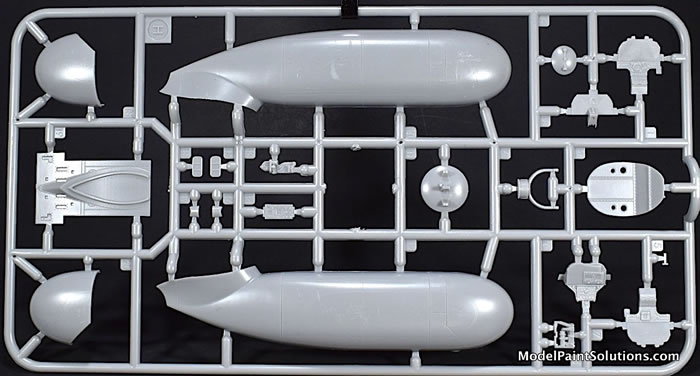
Added next are the engine exhausts each comprised of two photo-etch parts and a small styrene base that will look very scale appropriate when assembled. The four bladed props (comprised of 2-blade halves) and a 4-piece hub are assembled next followed by the nicely molded main gear with halved main wheels/tires. The main gear along with the associated actuators and doors are added next and here again, the level of detail is so high, you may want to display the built kit on a mirror for better viewing.
The crisply molded, crystal-clear canopies are next up and here the builder is provided the option of displaying both of the cockpits either open or closed—very nice. Die-cut vinyl masks are provided for the canopies as well as the main wheels/tires and the tail wheel.
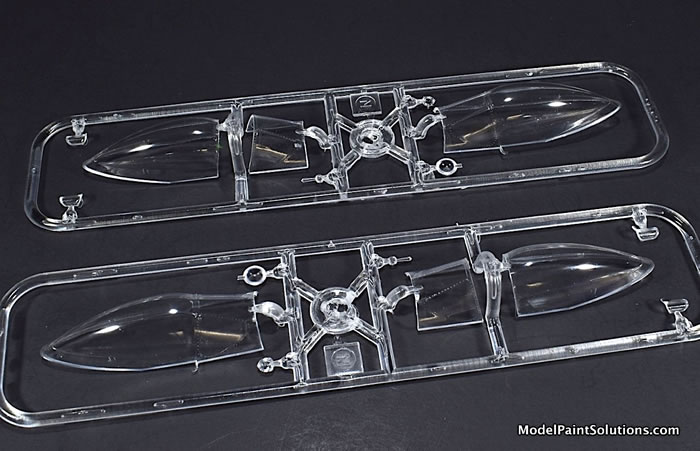
Should you wish to hang some ordinance on your F-82, 10 HVAR rockets along with launchers (each composed of 5 parts) and wing pylons are provided.
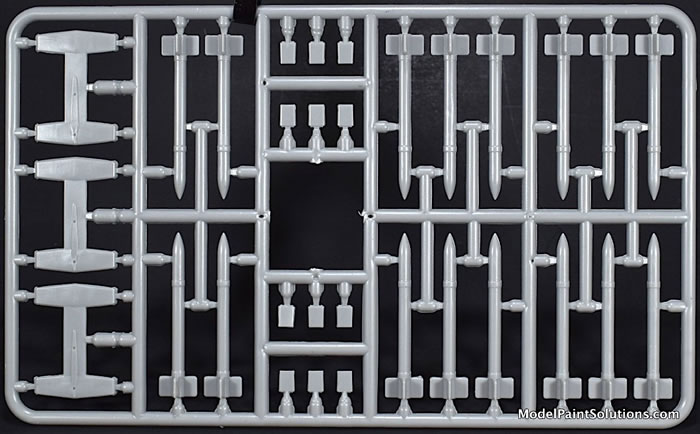
Long range tanks, comprised of halves, along with their pylons are also provided.
Marking Options
The decals, by Decograph are crisply printed with good registration, and color density.
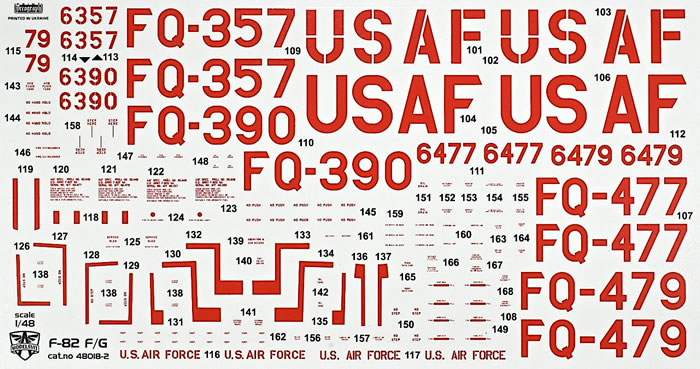
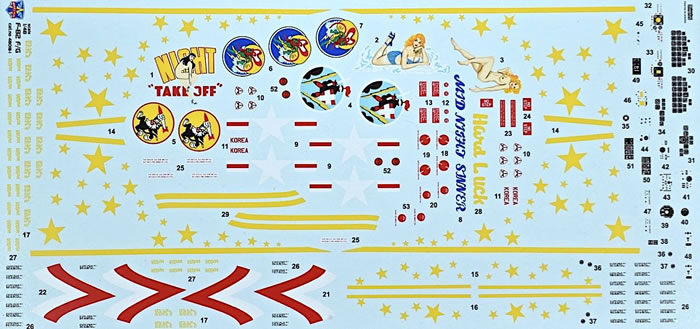
Markings and airframe stencils are provided for 4 airframes as follows:
-
F-82F Twin Mustang 46-477, FQ-477, 319 F(AW)S, USAF, Moses Lake Air Base, Washington State, 1950.
-
F-82F Twin Mustang 46-479, FQ-479, 5 F(AW)S, USAF, Mitchell Air Base, New York, 1949.
-
F-82G Twin Mustang 46-357, FQ-357, 68 F(AW)S, USAF, Itazuke Air Base, Kyushu, Japan, Summer, 1950.
-
F-82 Twin Mustang 46-390, FQ-390, 4 F(AW)S, USAF, Naha Air Base, Okinawa, Japan, Summer, 1950
Wow—I’m smitten; this is a beautiful kit—period. The surface textures are sublime, details abound, and the parts layout and assembly sequence are quite conventional. For those that like super-detailing, both of the cockpits and the radar nose cone can be displayed open. The beautifully printed decals provide markings for 4 colorful airframes and whichever scheme is applied, the result will be a head-turner for sure.
Highly Recommended!
--John
For more on this review visit Modelpaintsolutions.com.
Review kit provided by my wallet, again.
Review Text Copyright © 2020 by Model Paint Solutions
Page Created 17 March, 2022
Last updated
17 March, 2022
Back to HyperScale Main Page
Back to Reviews Page |
